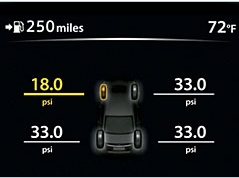
A new report from the National Highway Traffic Safety Administration (NHTSA) finds that vehicles equipped with a tire pressure monitoring system (TPMS) reduced the number of severely under-inflated tires on the road.
The report compared the percentage of severely under-inflated tires on passenger vehicles in model years 2004-2007 that came with and without tire pressure monitoring systems. A severely under-inflated tire is defined as 25 percent or more below the vehicle manufacturer's recommended inflation pressure.
The government required all new cars and light duty trucks to be equipped within a phase-in period starting in 2005. These systems are designed to alert the driver of one or more under-inflated tires. Some vehicles were equipped with TPMS before 2005, but by September 2007 all light duty vehicles had to comply.
Findings show TPMS is effective in reducing the percentage of under-inflated tires on the road. The survey collected data on 6,103 vehicles, 4,391 of which were equipped with TPMS.
Here are some of the survey findings and thoughts on under-inflated tires:
- Over 23 percent of 2004-2007 vehicles without TPMS had one or more severely under-inflated tire. In contrast, only about 12 percent of the vehicles in the same model years with TPMS had this issue.
- Vehicles with TPMS had a 55 percent reduction in the likelihood that there were one or more severely under-inflated tires on a vehicle.
- Under-inflated tires can adversely effecting handling, reduce tire tread life and lead to tire failure. Likewise over-inflated tires also affect vehicle handling and tire wear.
- The survey estimated TPMS resulted in an almost 31% reduction in the likelihood of a severely over-inflated tire.
- Only 5.7 percent of newer vehicles (model years 2008 to 2011), all with TPMS, had a severely under-inflated tire. A number of factors contributed to this difference, such as the maturity in TPMS technology and the differences in owner maintenance practices between older and newer cars.
- Under-inflated tires also have higher rolling resistance, which factors in fuel economy. TPMS in the first eight years of operation is estimated to have saved a typical car about 9.3 gallons of fuel (27.9 gallons for a light-duty truck). In 2011, TPMS is estimated to have saved about $511 million in reduced fuel consumption (not bad at all).
Final thought: If the TPMS alerts you that something's amiss, don't ignore it.





